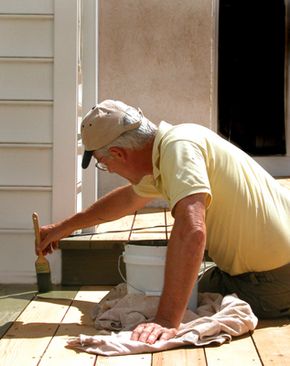Choosing exterior paints can be complicated because of the wide range of surfaces. These surfaces include clapboard and aluminum siding, wood shingles, tar shingles, cedar shakes, brick, concrete block, stucco, and, of course, old paint. On many older homes, you'll find a combination of these surfaces. Fortunately, there is an exterior paint for every type of surface, and some paints are suitable for more than one surface.
The links at the bottom of this page will take you to articles that will help you pick the best exterior paint for your project. You'll find a wide variety of exterior paint types and discover the best method to calculate the right amount of paint to use.
Advertisement
Like interior paints, exterior paints are available in either water-thinned or solvent-thinned formulas and in three lusters: flat, semigloss, and gloss. There are, however, several characteristics that distinguish exterior paints from those used inside the house. For one thing, exterior paints are more expensive. They also contain more resin (for moisture resistance and durability) and more pigment (for color).
You may want to choose your exterior paint based on what was used before. As with interior paints, latex works best over latex and alkyd works best over alkyd. If you can't tell or are unsure about what type of paint is on the house, use an alkyd-base paint.
Latex exterior paints are easier to apply, dry quickly, and can help minimize moisture problems because they "breathe." Cleaning up is a matter of soap and water. These paints do not adhere as well to oilbase or alkyd-base paints or to poorly prepared surfaces, however. Alkyds, on the other hand, are extremely durable, but they are more difficult to work with and they dry slowly. Also, solvents must be used with alkyds to clean brushes, rollers, paint trays, and drips.
One of the alkyd types of exterior paint may be especially appealing because of its regulated, self-cleaning property. It's called "chalking," and that's exactly what it does. Over a period of years, the paint surface slowly oxidizes. Each rainfall washes off a minute quantity of the paint -- along with dirt. As a result of this shedding, the paint surface is constantly renewing itself. The price of this convenience used to be chalky residue on foundations and shrubs, but the newest formulas control the shedding so it doesn't stain adjacent surfaces.
Chalking paint is not recommended for every house. In areas with little rainfall, for example, the powder tends to remain on the surface, dulling the paint. In wet regions, chalking paint may not be worth the extra expense because frequent rainfalls will keep the outside of the house clean no matter what kind of paint is used. If you live in or near either of these climatic extremes, ask your paint dealer if the chalking type is suitable for your area.
In the meantime, the following articles should answer many of your questions about exterior paints.
The kind of surface you're painting, the kind of look you want, and the kind of weather you're likely to encounter are all key factors to consider when choosing the right paint. Learn which type is right for you.
Buy too much paint, and you've got yourself a guaranteed space-eater. This article will help you assess how much exterior paint you need for a given job.
For more information on painting an on home improvement in general, see:
- Interior Paints: If you're planning to paint the inside of your house in addition to the outside, see this comprehensive list of interior paints.
- House Painting: For all things related to improving your home with paint, visit this page.
- Home Improvement: After you're done painting, learn how you can make other fixes in all parts of your home.
Advertisement
